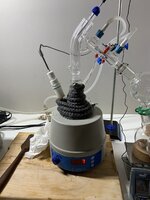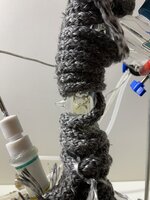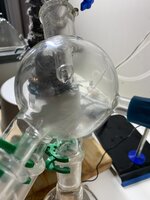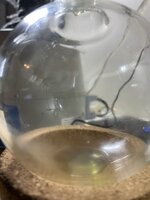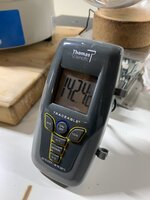Navigation
Install the app
How to install the app on iOS
How To Use Progressive Web App aka PWA On 420 Magazine Forum
Note: This feature may not be available in some browsers.
More options
You are using an out of date browser. It may not display this or other websites correctly.
You should upgrade or use an alternative browser.
You should upgrade or use an alternative browser.
The Honey Oil Thread: From Raw Bud & Trim, To RSO, Through An SPD, To Golden Love!
- Thread starter zeroday
- Start date
- Thread starter
- #82
zeroday
Well-Known Member
*** The Short Path Distillation Rig Assembly Post (5 of 6)***
Getting close to having this muther lover assembled! Now that we have the main section of the SPD Rig, the Cold Trap and the Vacuum all connected, its time to connect the Heat Bath.
The purpose of the Heat Bath is to constantly circulate water through the Condensing Head. We are working with compounds that are extremely thick as they cool down. We circulate water that is heated to 80c through the Head through the entire process. This will keep the fluids moving down the head, and into the Cow. Otherwise, it would gunk up from THC or Terpenes that thicken too quickly and clog the glass. In order to efficiently condense a liquid into a vapor, there only needs be a reduction of about 40c, maybe less. I set mine at 80c, because it is enough for my purposes, and all I can afford. The higher the temperature the unit goes, the more expensive it is. I purchased mine very used on ebay for $30.
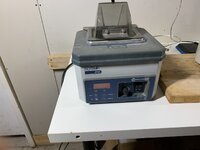
Oh yeah, the circulation part. Because I was going on the cheap as much as possible, I couldn't afford $1k to purchase a chilling/heating circulation unit. The heat bath I have is just that, a bath. It doesn't recirculate, it just keeps whatever is in the basin at a set temperature between ambient and 80c. I purchased a solar water circulation pump on Amazon for $28. I picked up tubing that is heat resistant up to 120c. Another item that is more expensive the higher the temperature rating.
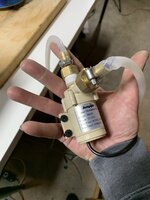
One tube coming from the pump connects to one of the ports on the Condensing Head. The other tube coming from the pump goes into the Heat Bath. The second port on the Condenser Head has tubing that goes directly to the Heat Bath. This allows the pump to keep the water circulating constantly at the set point we determine.
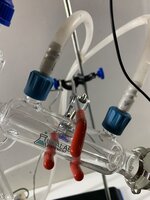
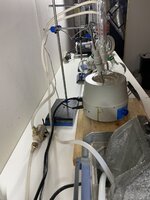
Getting close to having this muther lover assembled! Now that we have the main section of the SPD Rig, the Cold Trap and the Vacuum all connected, its time to connect the Heat Bath.
The purpose of the Heat Bath is to constantly circulate water through the Condensing Head. We are working with compounds that are extremely thick as they cool down. We circulate water that is heated to 80c through the Head through the entire process. This will keep the fluids moving down the head, and into the Cow. Otherwise, it would gunk up from THC or Terpenes that thicken too quickly and clog the glass. In order to efficiently condense a liquid into a vapor, there only needs be a reduction of about 40c, maybe less. I set mine at 80c, because it is enough for my purposes, and all I can afford. The higher the temperature the unit goes, the more expensive it is. I purchased mine very used on ebay for $30.

Oh yeah, the circulation part. Because I was going on the cheap as much as possible, I couldn't afford $1k to purchase a chilling/heating circulation unit. The heat bath I have is just that, a bath. It doesn't recirculate, it just keeps whatever is in the basin at a set temperature between ambient and 80c. I purchased a solar water circulation pump on Amazon for $28. I picked up tubing that is heat resistant up to 120c. Another item that is more expensive the higher the temperature rating.

One tube coming from the pump connects to one of the ports on the Condensing Head. The other tube coming from the pump goes into the Heat Bath. The second port on the Condenser Head has tubing that goes directly to the Heat Bath. This allows the pump to keep the water circulating constantly at the set point we determine.


- Thread starter
- #83
zeroday
Well-Known Member
Have you ever decarb the bud in an oven bag, eliminates smell, prior to starting the process? This would mean you could leave it on a hotplate at low to evaporate the remaining alcohol and water.
I know this is totally debatable, but I don't like to decarb bud unless I am using it for something that specifically calls for the use of plant material. If I am taking it to oil, I prefer to leave the decarb for the end. The thinking is that when you decarb it prior, your converting other things that you'll get in the filtering phase that you won't after they have been converted. The biggest one being Chlorophyll.
An experiment I did last run: I took two jars of bud, decarbed one. Then I washed both of them. The wash from the stuff that was decarbed prior had more of a brown in it where as the one that I didn't decarb had more of a golden yellow shade. Then after I evaporated off the ethanol, the resulting crude oil was a different color, taste and smell. I liked the one that was decarbed last.
Other thing is, my oven vents back into the room. So if anything inside smell, the first floor does. Fine with turkeys, not so much with weed! I'd love to have a vacuum oven in the lab, but sadly cannot afford one, yet.
I think its personal preference at the end of the day.
- Thread starter
- #84
zeroday
Well-Known Member
*** The Short Path Distillation Rig Assembly Post (4 of 6)***
Last quick item to complete and then we are ready to seal this baby up and get going.
The Heat Mantle has a thermometer that measures the temperature of the liquid inside the Boiling Flask and shuts the heat off and turns it on to keep it around the temperature you set. This doesn't mean you aren't going to overshoot the temperature you want. In fact, the entire time you'll be playing this game of chase, where you keep messing with the temperature by 10c increments at a time for 2 hours. It'll be fun, I promise!
Also, as mentioned prior, the most important thing in this game is the Head Temp. Without knowing what the temperature of the vapor inside the head, you won't know what it is that you are pulling. Also, the temperature in the head is generally much lower than the Boiling Flask, so you can't use the BF temp as input to whats happening up top. For the majority of the run, the head temperatures can be down between 30-50c, and obviously won't increase until something starts to vaporize off. For example, just prior to the THC vaporizing out of the Boiling flask, the liquid will be around 155c inside the Boiling flask, but the temperature inside the Head will be something like 40c. Then as the THC vaporizes and starts making its way up through the Vigreux, the temperature will begin to increase. When this happens, we stop focusing only on the temp in the Head, and start monitoring the color and consistency of the fluid coming down the Condenser Head.
With all that said, a few pics of the thermometers in place.
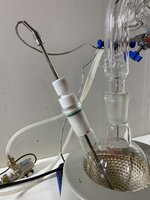
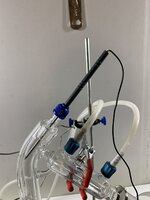
Last quick item to complete and then we are ready to seal this baby up and get going.
The Heat Mantle has a thermometer that measures the temperature of the liquid inside the Boiling Flask and shuts the heat off and turns it on to keep it around the temperature you set. This doesn't mean you aren't going to overshoot the temperature you want. In fact, the entire time you'll be playing this game of chase, where you keep messing with the temperature by 10c increments at a time for 2 hours. It'll be fun, I promise!
Also, as mentioned prior, the most important thing in this game is the Head Temp. Without knowing what the temperature of the vapor inside the head, you won't know what it is that you are pulling. Also, the temperature in the head is generally much lower than the Boiling Flask, so you can't use the BF temp as input to whats happening up top. For the majority of the run, the head temperatures can be down between 30-50c, and obviously won't increase until something starts to vaporize off. For example, just prior to the THC vaporizing out of the Boiling flask, the liquid will be around 155c inside the Boiling flask, but the temperature inside the Head will be something like 40c. Then as the THC vaporizes and starts making its way up through the Vigreux, the temperature will begin to increase. When this happens, we stop focusing only on the temp in the Head, and start monitoring the color and consistency of the fluid coming down the Condenser Head.
With all that said, a few pics of the thermometers in place.


- Thread starter
- #85
zeroday
Well-Known Member
Good evening folks... Its Saturday Night, I have a grinder full of weed, a six pack, two nips of tequilla, and I'm all gloved up with a full tube of grease. What to do?

- Thread starter
- #86
zeroday
Well-Known Member
Yeah... Vacuum Grease. I'll get to what it's for in a moment. But first....
I feel like I'm getting ahead of myself. Why a vacuum?
The purpose of the vacuum is to allow the various compounds to be separated without being exposed to oxygen. When straight up THC is exposed to Oxygen at high temperatures, it almost immediately begins to degrade. When you take a hit off of a joint, a bong, a bowl, a..... You send it to your lungs fast enough that it doesn't matter. However, sitting there over time as you extract it, the THC will break down.
If you've ever seen oil that has a red tint, instead of a golden honey color, its because it was either exposed to oxygen while it was being extracted, or it was exposed to oxygen while being stored. Some times its just a red Halo or Ring. In the business, they call it the "Red Ring".
My first batch, I accidentally opened the vacuum release and let the pressure equalize for a few seconds. I had the red ring, slightly. I was totally bummed, but lessons learned are valuable, aren't they?
The other thing the vacuum does is reduce the amount of energy required to produce the same temperatures. The force of the pressure on the liquid somewhat contains the heat.
A Micron is a unit that can be used to measure pressure. The lower the value, the better. To provide scale, at sea level average atmospheric pressure is around 760,000 Microns. We are shooting to be under 150 Microns. My last run, I was at 140 Microns most of the time, but it did bump down to 130 Microns here and there.
I feel like I'm getting ahead of myself. Why a vacuum?
The purpose of the vacuum is to allow the various compounds to be separated without being exposed to oxygen. When straight up THC is exposed to Oxygen at high temperatures, it almost immediately begins to degrade. When you take a hit off of a joint, a bong, a bowl, a..... You send it to your lungs fast enough that it doesn't matter. However, sitting there over time as you extract it, the THC will break down.
If you've ever seen oil that has a red tint, instead of a golden honey color, its because it was either exposed to oxygen while it was being extracted, or it was exposed to oxygen while being stored. Some times its just a red Halo or Ring. In the business, they call it the "Red Ring".
My first batch, I accidentally opened the vacuum release and let the pressure equalize for a few seconds. I had the red ring, slightly. I was totally bummed, but lessons learned are valuable, aren't they?
The other thing the vacuum does is reduce the amount of energy required to produce the same temperatures. The force of the pressure on the liquid somewhat contains the heat.
A Micron is a unit that can be used to measure pressure. The lower the value, the better. To provide scale, at sea level average atmospheric pressure is around 760,000 Microns. We are shooting to be under 150 Microns. My last run, I was at 140 Microns most of the time, but it did bump down to 130 Microns here and there.
- Thread starter
- #87
zeroday
Well-Known Member
We talked about vacuum pressure, and the importance getting it down as low as we can. We are using Microns as the unit of measurement. As a reminder, sea level atmospheric pressure is roughly 760,000 microns. We are shooting for less than 150 microns.
To begin the vacuum test, I first connect the pressure meter the vaccum, isolated from the rest of the system. In other words, the meter is connected directly to the inlet on the pump. I use the same T connector, and then use a block off KF-25 cap on one end of the T.
Unfortunately, I didn't get pictures. I panicked. The last two times I used this pump, I was able to get it down to 70 microns. This time, the pump was at 370 microns! Remember, the only possible leaks are between the port that we connect the T connector to the pump, the meter to the T, or the cap that blocks off the T. However, this all tested out the last bunch of times. While this is only my third run, I've done the vacuum test a dozen or more times.
I couldn't figure it out. This is a show stopper. Gotta get under 150 mirons. I checked the connections anyay, to no avail
Time for a break! Sat down and had a nice hit of Tangie via my Pax 2. Just a sip or two of Don Julio.

THE OIL!
Remember when I mentioned earlier on that some of the vapors make it past the cold trap and then make it into the pump? When that happens, the oil acts as filter, capturing some of the compounds. This in effect contaminates the oil and makes it less efficient.
To test my theory, I was going to pull the oil plug and let just a bit of it flow out to see the color and texture. As soon as it started flowing out, I immediately smelled that fowl "Heads" smell. I decided to remove all of the oil and replace it with fresh oil, AKA an oil change. I had a quart on hand. When got the pump, I changed the oil and bought a spare quart to have on hand.
The result? I fired it back up with meter connected. The meter raced down, getting down to 70 microns!
The oil is out in the shed sealed. I don't want it even stinking up the shed. I'd rather have the smell of the shit from the squirrels that live in it during the winter. Such a fowl smell! Yuck!
Anway...
To begin the vacuum test, I first connect the pressure meter the vaccum, isolated from the rest of the system. In other words, the meter is connected directly to the inlet on the pump. I use the same T connector, and then use a block off KF-25 cap on one end of the T.
Unfortunately, I didn't get pictures. I panicked. The last two times I used this pump, I was able to get it down to 70 microns. This time, the pump was at 370 microns! Remember, the only possible leaks are between the port that we connect the T connector to the pump, the meter to the T, or the cap that blocks off the T. However, this all tested out the last bunch of times. While this is only my third run, I've done the vacuum test a dozen or more times.
I couldn't figure it out. This is a show stopper. Gotta get under 150 mirons. I checked the connections anyay, to no avail
Time for a break! Sat down and had a nice hit of Tangie via my Pax 2. Just a sip or two of Don Julio.

THE OIL!
Remember when I mentioned earlier on that some of the vapors make it past the cold trap and then make it into the pump? When that happens, the oil acts as filter, capturing some of the compounds. This in effect contaminates the oil and makes it less efficient.
To test my theory, I was going to pull the oil plug and let just a bit of it flow out to see the color and texture. As soon as it started flowing out, I immediately smelled that fowl "Heads" smell. I decided to remove all of the oil and replace it with fresh oil, AKA an oil change. I had a quart on hand. When got the pump, I changed the oil and bought a spare quart to have on hand.
The result? I fired it back up with meter connected. The meter raced down, getting down to 70 microns!
The oil is out in the shed sealed. I don't want it even stinking up the shed. I'd rather have the smell of the shit from the squirrels that live in it during the winter. Such a fowl smell! Yuck!
Anway...
- Thread starter
- #88
zeroday
Well-Known Member
With a pump full of fresh oil, we proceed with the Vacuum Test. I reconnect the T and all into the right place.
At this point, I haven't done anything in terms of greasing the glass joints or using Teflon tape on the vacuum joints. I wanted to see what we were pulling as a baseline. When the rig gets pressurized, its not instant. It takes a bit to get down to the lowest pressure the pump will pull. I turned on the pump and sat down to wait for the pressure to settle.
Not horrible, because we haven't done anything to seal it. But at least I know what the pump will pull with the glass connected raw, with no help. It is said that premium glass can get down to the same level as the pump without grease. Again, moe money...
Without any sealing, we are pulling 1250 microns. With the glass we have, I am pleased with this.
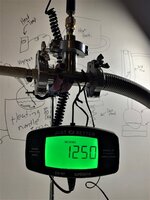
Before we bust out the grease, I wanted to hit the air connections with Teflon Tape. Example:
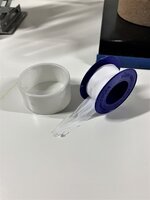
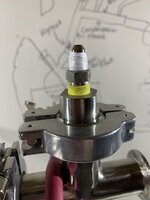
After hitting the connections between the meter and the T conector, as well as between the KF-25 adapter between the pump outlet the bellow hose with Teflon Tape, I turned the pump back on to get another reading.
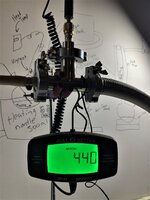
Down to 440 microns now. Things are looking good.
Gonna take a break, inhale some food and come back.
At this point, I haven't done anything in terms of greasing the glass joints or using Teflon tape on the vacuum joints. I wanted to see what we were pulling as a baseline. When the rig gets pressurized, its not instant. It takes a bit to get down to the lowest pressure the pump will pull. I turned on the pump and sat down to wait for the pressure to settle.
Not horrible, because we haven't done anything to seal it. But at least I know what the pump will pull with the glass connected raw, with no help. It is said that premium glass can get down to the same level as the pump without grease. Again, moe money...
Without any sealing, we are pulling 1250 microns. With the glass we have, I am pleased with this.

Before we bust out the grease, I wanted to hit the air connections with Teflon Tape. Example:


After hitting the connections between the meter and the T conector, as well as between the KF-25 adapter between the pump outlet the bellow hose with Teflon Tape, I turned the pump back on to get another reading.

Down to 440 microns now. Things are looking good.
Gonna take a break, inhale some food and come back.
- Thread starter
- #89
zeroday
Well-Known Member
Ok, time for Grease! Not just any grease, this is High Temperature Vacuum Grease. We will use it at the joints where we connect any two pieces of glass together. There certainly is such a thing as two much or two little. The trick is to have enough.
Instead of posting a picture again, I figured would ask you all to refer above, instead of wasting space and posting it again. Its Dow Corning Vacuum Grease. Good stuff.
I'm hoping we all get the idea of male and female connections and there is no political correctness that will stomp on me... But just in case, there is one part that goes into another. The part that is being inserted is the Male connection, the part that the male connection is being inserted into is the female connection.
Make sure to be wearing nitrile gloves and have plenty of paper towels abound. The idea is, put a dab of the grease the size of an M&M on your finger tip. Then swirl it around the male end of the glass connection. Start at the top and go 1/4 to half way down. I like going with a conservative amount. You can always add more later if required.
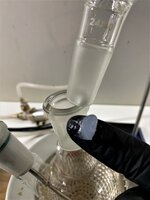
Once you have it applied, place the male end into the female side of the glass. Once you have it inserted, turn it half way back and forth. You'll notice that as you do, the grease fills in the grooved glass. About that, the glass is clouded because it is purposely roughed up.
The first picture was taken right after you insert the male end into the female end. Notice the grease has cleared the cloudy glass. However, not evenly. Turning it back and forth with work the grease around. The second picture is just after rotating the flask back and forth to work the grease into all of the grooves.
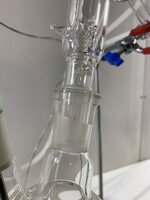
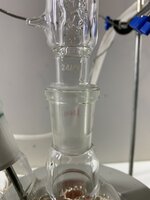
Here is a picture on the Receiving Flasks on the Triple Cow. The one of the top is greased, the one of the bottom is not. Notice the difference in the cloudiness of the glass.
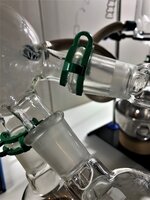
The top one is correct, the bottom one is not.
After getting all of the glass joints greased, we connect everything and start the vacuum pump up. We are now at 160 microns. Not quite there, but progress none the less.
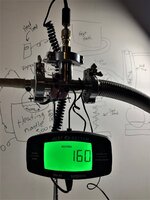
Knowing that I have Teflon Tape where it needs to be, and vacuum grease where it needs to be, I wonder where there could be a leak. I could be one of the hinge clamps that are part of the air side of the rig. Knowing how well the clamps work, I decide to look elsewhere.
I guess the most notorious place for a leak is the thermometers. I decided to throw some Teflon tape between the thermometer and the adapter. I also put some vacuum grease on the PTFE adpater that goes into the glass. Ater doing that, we get down to 90 microns.
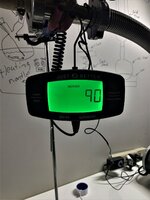
Instead of posting a picture again, I figured would ask you all to refer above, instead of wasting space and posting it again. Its Dow Corning Vacuum Grease. Good stuff.
I'm hoping we all get the idea of male and female connections and there is no political correctness that will stomp on me... But just in case, there is one part that goes into another. The part that is being inserted is the Male connection, the part that the male connection is being inserted into is the female connection.
Make sure to be wearing nitrile gloves and have plenty of paper towels abound. The idea is, put a dab of the grease the size of an M&M on your finger tip. Then swirl it around the male end of the glass connection. Start at the top and go 1/4 to half way down. I like going with a conservative amount. You can always add more later if required.

Once you have it applied, place the male end into the female side of the glass. Once you have it inserted, turn it half way back and forth. You'll notice that as you do, the grease fills in the grooved glass. About that, the glass is clouded because it is purposely roughed up.
The first picture was taken right after you insert the male end into the female end. Notice the grease has cleared the cloudy glass. However, not evenly. Turning it back and forth with work the grease around. The second picture is just after rotating the flask back and forth to work the grease into all of the grooves.


Here is a picture on the Receiving Flasks on the Triple Cow. The one of the top is greased, the one of the bottom is not. Notice the difference in the cloudiness of the glass.

The top one is correct, the bottom one is not.
After getting all of the glass joints greased, we connect everything and start the vacuum pump up. We are now at 160 microns. Not quite there, but progress none the less.

Knowing that I have Teflon Tape where it needs to be, and vacuum grease where it needs to be, I wonder where there could be a leak. I could be one of the hinge clamps that are part of the air side of the rig. Knowing how well the clamps work, I decide to look elsewhere.
I guess the most notorious place for a leak is the thermometers. I decided to throw some Teflon tape between the thermometer and the adapter. I also put some vacuum grease on the PTFE adpater that goes into the glass. Ater doing that, we get down to 90 microns.

- Thread starter
- #90
zeroday
Well-Known Member
This space ship is ready to fly captain! 
Its late at this point, and I've had a couple of those beers, and a few sips of that Tequila. I'm turning in for the night. 11am ET Start time on the rig. Now that everything is ready and tested, all I need to do is drop the oil in and let it run! Give or take.
Rest well folks!


Its late at this point, and I've had a couple of those beers, and a few sips of that Tequila. I'm turning in for the night. 11am ET Start time on the rig. Now that everything is ready and tested, all I need to do is drop the oil in and let it run! Give or take.
Rest well folks!
- Thread starter
- #91
zeroday
Well-Known Member
*** The Short Path Distillation Run Post ***
Ok, here we go. Up until now, I've been posting hours or maybe the next day. I'm going to attempt to post as I go for the actual run.
I've been at it for about 45 minutes now. I did a final weigh in. The crude oil going in is 60.1 grams.
Current parameters:
Boil Flask Set Point: 50c
BF Temp: 47c
Head Temp: 26.2c
Vacuum: 90 microns
Heat Bath: 50c
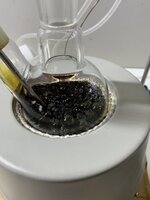
Ok, here we go. Up until now, I've been posting hours or maybe the next day. I'm going to attempt to post as I go for the actual run.
I've been at it for about 45 minutes now. I did a final weigh in. The crude oil going in is 60.1 grams.
Current parameters:
Boil Flask Set Point: 50c
BF Temp: 47c
Head Temp: 26.2c
Vacuum: 90 microns
Heat Bath: 50c

- Thread starter
- #92
zeroday
Well-Known Member
- Thread starter
- #93
zeroday
Well-Known Member
- Thread starter
- #94
zeroday
Well-Known Member
- Thread starter
- #95
zeroday
Well-Known Member
- Thread starter
- #96
zeroday
Well-Known Member
- Thread starter
- #97
zeroday
Well-Known Member
Seems there is an issue with the vacuum pressure. I've checked all connections. I have a feeling it was caused by when I started. I didn't load the dry ice first, I started the vacuum and heat mantle. When the system presurrized, the temperature rises way faster than it would under no pressure. This gassed the oil, or in other words contaminated it. All of the connections check out, so its the only thing I can think. Nothing I can do now, except move on.

- Thread starter
- #98
zeroday
Well-Known Member
- Thread starter
- #99
zeroday
Well-Known Member
- Thread starter
- #100
zeroday
Well-Known Member
We have THC Oil Dripping!
Pic of the second drop. The first made it into the heads Receiving Flask. When it was hanging, the color was right, but I wanted to see it fall in order to judge the consistency. It dropped, I claimed oil strike, and by the time I managed to get the cow rotated to the Mains Receiving Flask, the first drop had already rolled into the Heads Recieving Flask.
Head Temp is at 158.2c, Bouncing up to 163c or so

Note, we are under where CBD comes off, so if there were any in the oil, its still waiting to be tapped. I'm still debating if I should try and Isolate the THC as much as possible, and switch Receiving Flasks, or if I should just let the THC and Terpenes mix. I have a thought on that, but later.

Pic of the second drop. The first made it into the heads Receiving Flask. When it was hanging, the color was right, but I wanted to see it fall in order to judge the consistency. It dropped, I claimed oil strike, and by the time I managed to get the cow rotated to the Mains Receiving Flask, the first drop had already rolled into the Heads Recieving Flask.
Head Temp is at 158.2c, Bouncing up to 163c or so


Note, we are under where CBD comes off, so if there were any in the oil, its still waiting to be tapped. I'm still debating if I should try and Isolate the THC as much as possible, and switch Receiving Flasks, or if I should just let the THC and Terpenes mix. I have a thought on that, but later.
Similar threads
- Replies
- 55
- Views
- 89K
- Replies
- 0
- Views
- 3K



